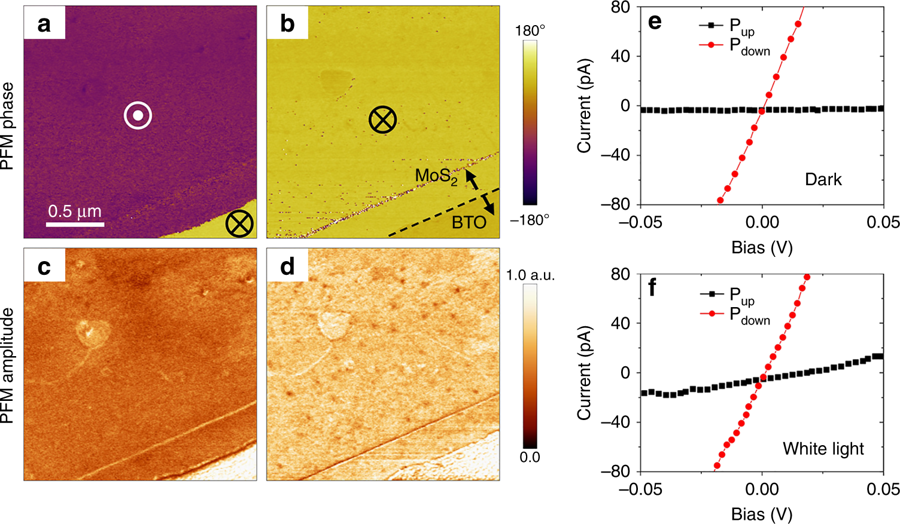“In the ferroelectric devices, polarization control is usually accomplished by application of an electric field.”* In the article “Optical control of polarization in ferroelectric heterostructures” Tao Li et al. demonstrate optically induced polarization switching in BaTiO3-based ferroelectric heterostructures utilizing a two-dimensional narrow-gap semiconductor MoS2 as a top electrode.
NANOSENSORS PPP-EFM PtIr coated AFM probes were used to perform the KPFM and PFM measurements mentioned in the article cited below.

Figure 1 from “Optical control of polarization in ferroelectric heterostructures”:
Electrically induced polarization switching in the MoS2/BaTiO3/SrRuO3 junction. a, b PFM phase (a) and amplitude (b) images after application of a negative voltage pulse (−5 V, 0.5 s) to the MoS2 flake. The 12-u.c.-thick BTO film underneath the MoS2 flake is fully switched to the upward polarization, Pup. c, d PFM phase (c) and amplitude (d) images after application of several positive voltage pulses (+5 V, 0.5 s) to the MoS2 flake. BTO underneath the MoS2 flake is fully switched to downward polarization, Pdown. The polarization state of the bare BTO film (at the lower right corner) is not affected by the electrical bias. e, f The I–V characteristics of the same junction measured in the dark and during illumination. The tunneling current for the OFF state (Pup) is largely increased under illumination
*Tao Li, Alexey Lipatov, Haidong Lu, Hyungwoo Lee, Jung-Woo Lee, Engin Torun, Ludger Wirtz, Chang-Beom Eom, Jorge Íñiguez, Alexander Sinitskii, Alexei Gruverman
Optical control of polarization in ferroelectric heterostructures
Nature Communications, volume 9, Article number: 3344 (2018)
DOI: https://doi.org/10.1038/s41467-018-05640-4
Please follow this external link to read the full article: https://rdcu.be/bdFYw
Open Access: The article “Optical control of polarization in ferroelectric heterostructures” by Tao Li et. Al. is licensed under a Creative Commons Attribution 4.0 International License, which permits use, sharing, adaptation, distribution and reproduction in any medium or format, as long as you give appropriate credit to the original author(s) and the source, provide a link to the Creative Commons license, and indicate if changes were made. The images or other third party material in this article are included in the article’s Creative Commons license, unless indicated otherwise in a credit line to the material. If material is not included in the article’s Creative Commons license and your intended use is not permitted by statutory regulation or exceeds the permitted use, you will need to obtain permission directly from the copyright holder. To view a copy of this license, visit http://creativecommons.org/licenses/by/4.0/.